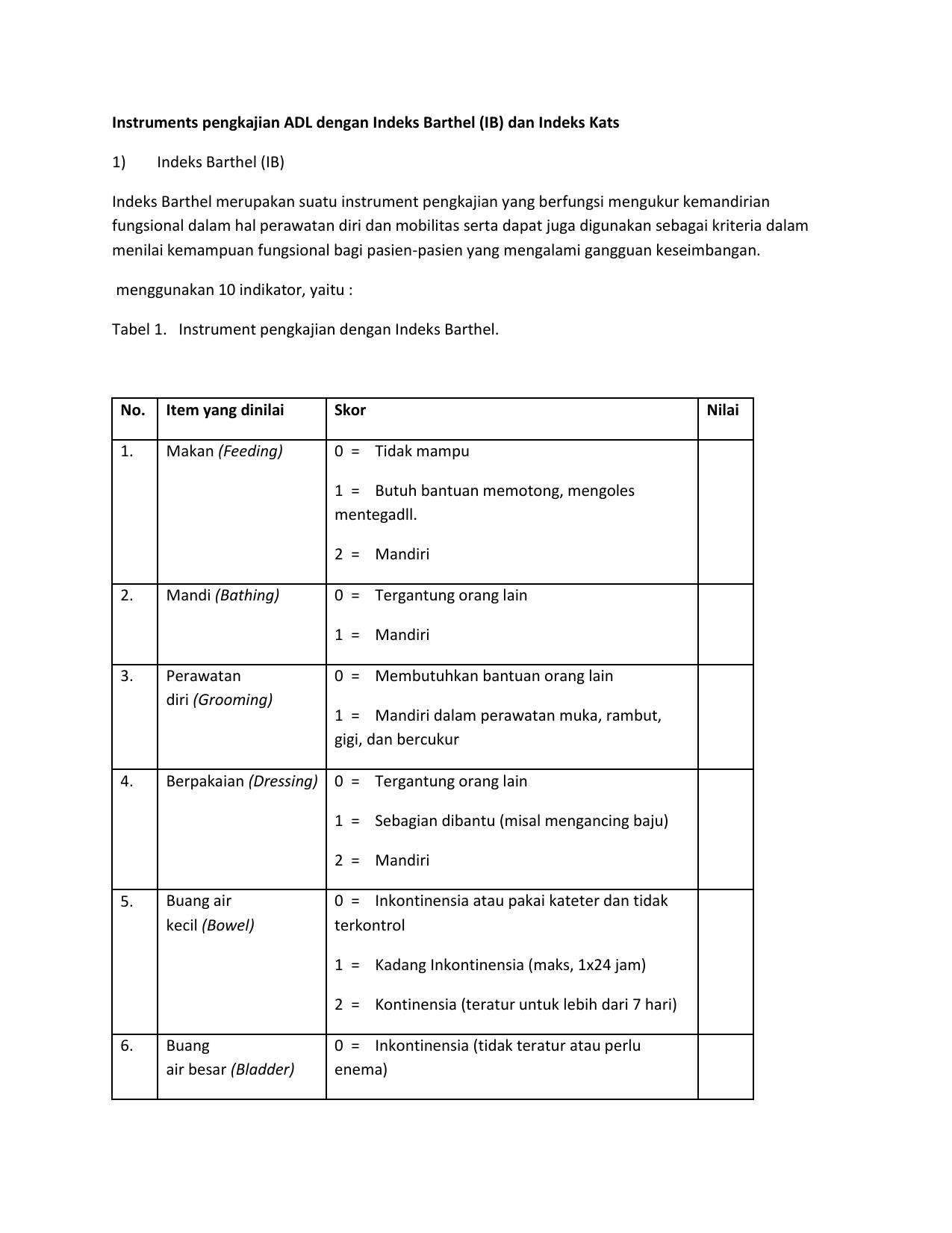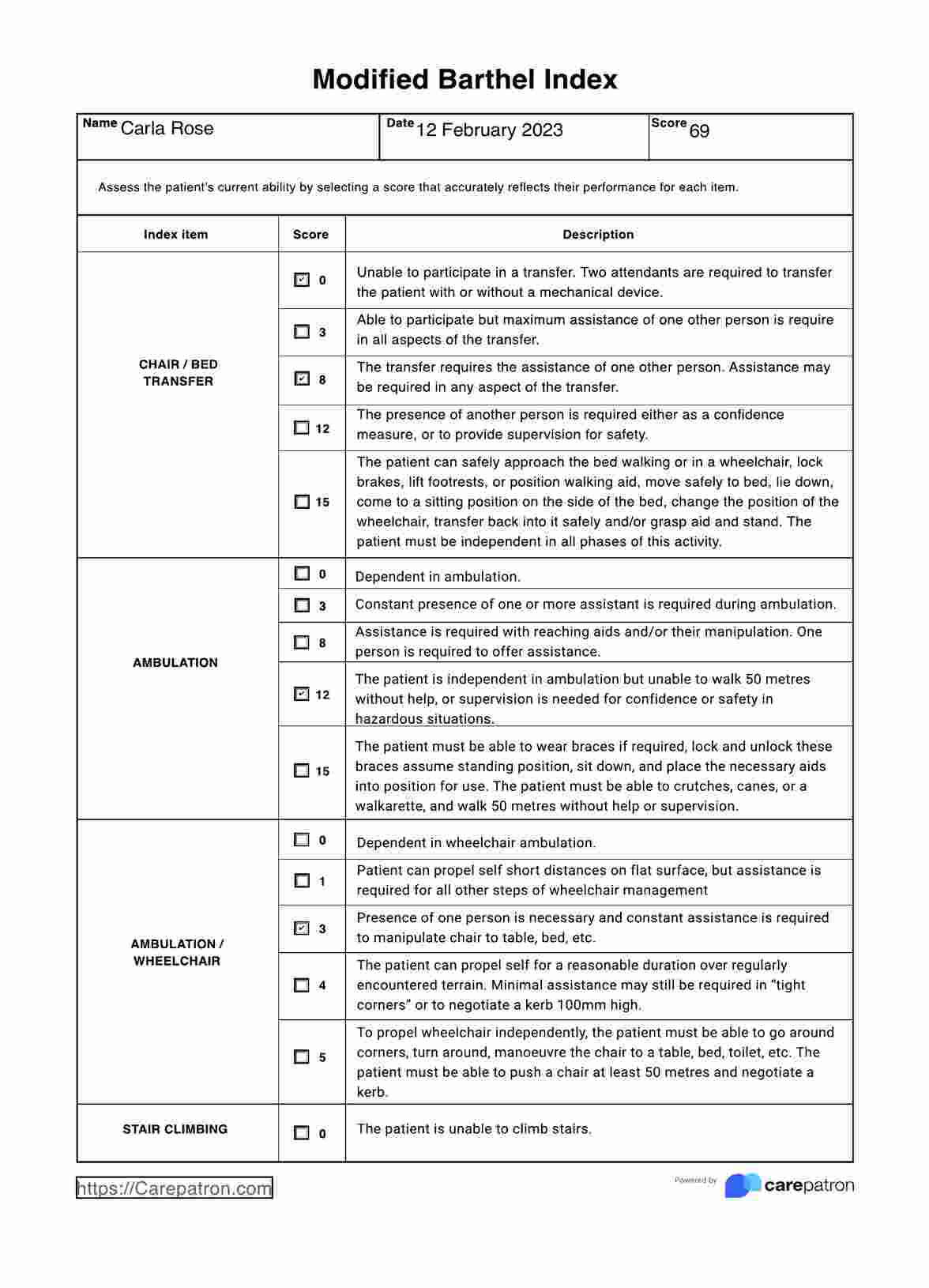World Updates | Update information about politics and social around the world
Barthel Index: Measuring Functional Independence In Daily Activities
The Barthel Index is a widely used tool to measure functional independence in daily activities. Developed by Dr. Roland Barthel in 1965, it assesses an individual's ability to perform ten essential activities of daily living (ADLs). The index provides a comprehensive measure of an individual's functional status and is commonly used in clinical settings, rehabilitation programs, and long-term care facilities.

Barthel Index Md Calc - Image to u - Source imagetou.com
Editor's Notes: The "Barthel Index: Measuring Functional Independence in Daily Activities" was published on [Insert publication date]. It discusses the importance of assessing functional independence and provides valuable insights into how the Barthel Index is used.
To ensure comprehensive understanding, we conducted thorough analyses, gathered relevant information, and summarized key insights in this guide. Our goal is to empower our readers with the necessary knowledge to make informed decisions.
Key Differences:
| Assessment | Areas Evaluated | Scoring |
|---|---|---|
| Barthel Index | Essential ADLs (e.g., eating, bathing, dressing) | 0-100 points (higher scores indicate greater independence) |
| Functional Independence Measure | Comprehensive range of ADLs and motor functions | 1-7 points (higher scores indicate greater independence) |
| Modified Rankin Scale | Disability after stroke | 0-6 points (lower scores indicate less disability) |
Main Article Topics:
FAQ
This FAQ section provides essential information and guidance on the Barthel Index, an assessment tool used to measure functional independence in daily activities.

Barthel Index & Example | Free PDF Download - Source www.carepatron.com
Question 1: What is the Barthel Index?
The Barthel Index is a widely used assessment tool that evaluates an individual's ability to perform ten essential activities of daily living (ADLs). It provides a comprehensive measure of functional independence, with higher scores indicating greater independence.
Question 2: What are the ten activities assessed by the Barthel Index?
The ten ADLs assessed include:
- Feeding
- Bathing
- Grooming
- Dressing
- Bowel and bladder control
- Toilet use
- Transferring
- Mobility
- Stairs
- bathing
Question 3: How is the Barthel Index administered?
The Barthel Index is typically administered by a healthcare professional, such as a nurse or physical therapist. The assessor observes the individual performing the ADLs and assigns a score based on the level of assistance required. Each activity is scored on a 0-4 scale, with 0 indicating total dependence and 4 indicating complete independence.
Question 4: What are the clinical applications of the Barthel Index?
The Barthel Index has various clinical applications, including:
- Assessing functional status in rehabilitation and long-term care
- Monitoring changes in functional independence over time
- Planning rehabilitation interventions and setting functional goals
- Evaluating outcomes of interventions and treatments
Question 5: What are the limitations of the Barthel Index?
While the Barthel Index is a valuable tool, it has some limitations. It may not capture subtle changes in functional ability, and it may not be sensitive to changes in cognitive or psychological functioning.
Question 6: Are there alternative assessment tools for measuring functional independence?
Yes, there are several other assessment tools that can measure functional independence, such as:
- Functional Independence Measure (FIM)
- Modified Rankin Scale
- Glasgow Outcome Scale
The choice of assessment tool depends on the specific needs and goals of the assessment.
Summary:
The Barthel Index is a widely used and valuable tool for measuring functional independence in daily activities. It provides a comprehensive assessment of essential ADLs, aiding in planning interventions, monitoring progress, and evaluating outcomes. Healthcare professionals should be aware of its limitations and consider alternative assessment tools when necessary.
Transition:
For further information on the Barthel Index and its applications, please consult the following resources:
Tips
Barthel Index: Measuring Functional Independence In Daily Activities is a widely used tool for assessing an individual's ability to perform activities of daily living (ADLs). Here are some tips to ensure reliable use of the Barthel Index:

Modified Barthel Index - Source fity.club
Tip 1: Train raters thoroughly.
Raters should be trained in the administration and scoring of the Barthel Index to ensure consistency and accuracy.
Tip 2: Observe the individual performing activities.
Direct observation provides a more accurate assessment of the individual's functional abilities than relying solely on self-report.
Tip 3: Consider the individual's cognitive status.
If the individual has cognitive impairment, their ability to understand and follow instructions should be taken into account.
Tip 4: Provide necessary equipment.
Ensuring the individual has access to appropriate assistive devices or equipment can improve their functional performance.
Tip 5: Record detailed observations.
Documenting the individual's performance, including any difficulties or adaptations, provides a comprehensive record for tracking progress.
Barthel Index: Measuring Functional Independence In Daily Activities
The Barthel Index (BI) is an assessment tool for measuring functional independence in daily activities among individuals with physical impairments or cognitive disabilities. Here are 6 key aspects of the BI:
- Comprehensive: 10 items cover a range of basic ADLs.
- Objective: Based on direct observation.
- Reliable: Good inter-rater reliability and test-retest reliability.
- Valid: Reflects real-world functioning.
- Applicable: Used in rehabilitation, research, and clinical settings.
- Sensitive: Detects changes in functional status over time.
The BI provides valuable information about an individual's ability to perform essential daily activities, such as feeding, dressing, and using the toilet. It can be used to assess progress in rehabilitation, plan interventions, and determine appropriate levels of care. The BI is commonly used in the rehabilitation of stroke, spinal cord injury, and other conditions that affect functional independence.

Barthel Index of Activities of Daily Living - University of Iowa Health - Source www.yumpu.com
Barthel Index: Measuring Functional Independence In Daily Activities
The Barthel Index is a widely used tool for assessing functional independence in daily activities. It is commonly employed in various healthcare settings, such as hospitals, rehabilitation centers, and nursing homes, to evaluate patients' ability to perform essential tasks independently. The index provides valuable insights into the individual's functional status and can assist in developing appropriate interventions to improve their independence and quality of life.

Modified Barthel Index & Example | Free PDF Download - Source www.carepatron.com
The Barthel Index consists of ten items that assess different aspects of daily functioning, including activities related to self-care, mobility, and social interaction. Each item is scored on a scale of 0 to 4, with 0 indicating complete dependence and 4 indicating complete independence. The total score ranges from 0 to 100, with higher scores indicating greater functional independence. The Barthel Index is a reliable and valid measure that has been widely used in research and clinical practice to assess functional outcomes in various patient populations.
Understanding the connection between the Barthel Index and functional independence in daily activities is crucial for healthcare professionals. It enables them to accurately assess patients' functional abilities and identify areas where they may need support or intervention. This information can guide treatment planning, rehabilitation strategies, and care coordination to optimize patient outcomes and promote their independence in daily living.
Numerous studies have demonstrated the utility of the Barthel Index in clinical practice. For instance, a study conducted in a rehabilitation center found that the Barthel Index was a significant predictor of functional outcomes in stroke patients, with higher scores associated with better functional recovery. Another study in a nursing home setting showed that the Barthel Index was useful in identifying patients at risk of functional decline, allowing for timely interventions to prevent further loss of independence.
Overall, the Barthel Index is a valuable tool for assessing functional independence in daily activities. It provides healthcare professionals with objective data to evaluate patients' functional abilities, guide treatment decisions, and monitor progress over time. Understanding the connection between the Barthel Index and functional independence is essential for optimizing patient outcomes and promoting their well-being in various healthcare settings.